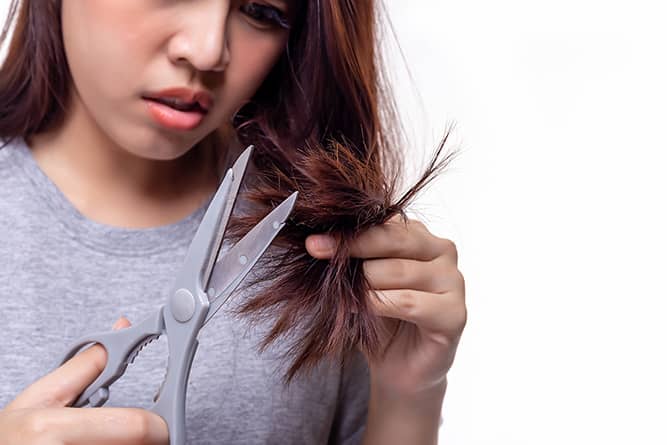The term “hair breakage” refers to the disintegration of an inner cuticle with overlapping scales that aids in the bonding of hair. When the scales fall off, the hairs get dry and separate from one another, resulting in split ends and shortened hair strands. If this type of damage is not handled, it can progress to full-blown hair breakage with strands falling out entirely.57
Causes of hair breakage 58
Physical and chemical damage are the two main causes of hair breaking.
Physical damage includes:
Overuse of hot equipment
Over-washing
Incorrect towel drying
Over-pulling the hair
Chemical damage includes:
Treatments
Dye jobs
Ultraviolet and visible radiation
There is currently a great deal of interest not only in developing products to protect and restore damaged hair but also in developing effective protocols to investigate the impact of these treatments and attest their efficacy. If your hair is breaking, this indicates that damage has already occurred. However, you can address the current breakage to prevent it from worsening. This can be accomplished by moisturizing the hair and by treating it with protein.
How to Prevent & Treat Hair Breakage?59
Moisturizing to repair damaged hair:59
A popular solution for those wondering how to moisturize damaged hair is oil. Olive oil can be massaged into the ends and scalp of dry hair. For best results, cover the scalp with a shower cap and leave the oil on the hair for as long as you like, preferably overnight. While oil treatments do not repair the inner core of the hair like protein supplements do, they do help to increase shine and add softness to the hair.
Protein to repair damaged hair: 59
Protein is required for hair reconstruction and cuticle strengthening. Protein treatments should be used after each shampooing. The added protein will help to strengthen the cuticle and repair split ends over time, making your hair more resistant to abuse.
According to a study conducted in 2013, the protein formulation of cD-crystallin can recover and improve the mechanical properties of chemically damaged hair. It is a very promising agent that strengthens the development of new restorative hair care products. 60
In fact, a simple method for quantifying hair damage caused by combing or brushing has been developed. The method entails collecting hair fragments that are chipped from hair during combing and quantitatively measuring the amount of protein using a colorimetric procedure.61
Manage the heat you expose your hair to: 59
Use a low heating setting when blow drying your hair or using a hot comb or a curling iron. Better yet, if possible, rely on non-harsh products to style your hair as opposed to heating. Also, it is always best to let your hair air dry!
Follow healthy hair care habits: 59
After every shampoo, make sure you condition your hair to give it the moisture it needs. Use a wide-tooth comb to brush your hair and avoid pulling and tugging at your hair to prevent it from damage. If you wear weaves and extensions, make sure they are professional and are light on your head and hair, and do not keep them on for a period longer than three months.
On a final note, while hair breakage is common, it can be avoided and hair can be improved if the proper precautions and treatments are taken. Protein and moisture should be your to-go-to treatment. Also, it might be a good idea to take a break from the hot tools and color jobs for a while. Adopting a healthy and consistent hair care routine is, of course, essential for having healthy, strong strands from the root to the tip. In events of hair loss or hair thinning, use of hair care products such as Regaine® can aid in hair regrowth as it contains minoxidil as it helps increase the supply of blood and nutrients to your hair follicles helping to strengthen the existing hairs and encouraging them to grow.59
References:
57 Brown, A. C., & Swift, J. A. (1975). Hair breakage: the scanning electron microscope as a diagnostic tool. J Soc Cosmet Chem, 26, 289-297.
58 Nogueira, A. C. S., & Joekes, I. (2004). Hair color changes and protein damage caused by ultraviolet radiation. Journal of photochemistry and photobiology B: Biology, 74(2-3), 109-117.
59 https://www.aad.org/public/diseases/hair-loss/insider/stop-damage
60 Ribeiro, A., Matamá, T., Cruz, C. F., Gomes, A. C., & Cavaco‐Paulo, A. M. (2013). Potential of human γ D‐crystallin for hair damage repair: insights into the mechanical properties and biocompatibility. International journal of cosmetic science, 35(5), 458-466.
61 Sandhu, S. S., & Ramachandran, R. (1995). A simple and sensitive method using protein loss measurements to evaluate damage to human hair. J Soc Cosmet Chem, 46, 39-52.

